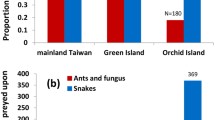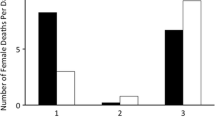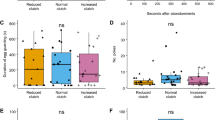Abstract
Why do most animal species not provide parental care to their eggs or progeny? The “cost” hypothesis suggests that parental care can reduce food intake, probable survivorship, and/or subsequent fecundity of the reproductive female, and parental care is not adaptive unless it is balanced by considerable fitness trade-offs. Therefore, parental care would be expected to evolve most often in species in which such costs are minor or insignificant. Although parental care has been reported in more than 140 species of reptiles, few records unambiguously demonstrate the cost of parental care. In the current study, I report the “costs” of maternal activities and survivorship, as well as egg attendance times, and within- and between-seasonal body size variations, of females of Mabuya longicaudata after engaging in parental care. I used those data to test whether parental care necessarily entailed large costs to mother lizards. The proportion of nests guarded decreased with time after eggs were laid, with most females remaining at the nest for at least 1 week, but then some beginning to leave. The loss of mass by females over the first week of egg guarding was on average balanced by a gain in mass during subsequent foraging bouts. The snout–vent length (SVL), body mass (BM), recapture (survival) rates, fecundity, timing of a second clutch, and clutch frequencies of females that exhibited long-term parental care (more than 28 days; mean, 31.6 ± 2.2 days) did not significantly differ from that of females that showed short-term parental care (9∼16 days; mean, 12.5 ± 2.3 days). Thus, my data indicate that intense parental care over a long period does not necessarily entail major energy costs for the mother in terms of SVL, BM, recapture (survival) rates, or fecundity.




Similar content being viewed by others
References
Annett CA, Pierotti R, Baylis JR (1999) Male and female parental roles in the monogamous cichlid, Tilapia mariae, introduced in Florida. Environ Biol Fishes 54:283–293
Aubret F, Bonnet X, Shine R, Maumelat S (2005) Energy expenditure for parental care may be trivial for brooding pythons, Python regius. Anim Behav 69:1043–1053
Bell G (1984) Measuring the cost of reproduction. II. The correlation structure of the life tables of five freshwater invertebrates. Evolution 38:314–326
Bolduc F, Guillemette M (2003) Incubation constancy and mass loss in the common eider Somateria mollissima. Ibis 145:329–332
Brown GP, Shine R (2004) Maternal nest-site choice and offspring fitness in a tropical snake (Tropidonophis mairii, Colubridae). Ecology 85:1627–1634
Burrowes PA (2000) Parental care and sexual selection in the Puerto Rican cave-dwelling frog, Eleutherodactylus cooki. Herpetologica 56:375–386
Carrillo J, Aparicio JM (2001) Nest defence behaviour of the Eurasian kestrel (Falco tinnunculus) against human predators. Ethology 107:865–875
Cichon M (2001) Body-mass changes in female collared flycatchers: state-dependent strategy. Auk 118:550–552
Clutton-Brock TH (1991) The evolution of parental care. Princeton University Press, Princeton, N.J.
Cook CL, Ferguson JWH, Telford SR (2001) Adaptive male parental care in the giant bullfrog, Pyxicephalus adspersus. J Herpetol 35:310–315
Dearborn DC (2001) Body condition and retaliation in the parental effort decisions of incubating great frigatebirds (Fregata minor). Behav Ecol 12:200–206
Eisenberg J (1981) The mammalian radiations. University of Chicago Press, Chicago, Ill.
Farmer CG (2000) Parental care: the key to understanding endothermy and other convergent features in birds and mammals. Am Nat 155:326–334
Fitch HS (1970) Reproductive cycles in lizards and snakes. Univ Kans Mus Nat Hist Misc Publ 52:1–247
Gorman HE, Nager RG (2003) State-dependent incubation behaviour in the zebra finch. Anim Behav 65:745–754
Greene MJ, Stark SL, Mason RT (2002) Predatory response of brown tree snakes to chemical stimuli from human skin. J Chem Ecol 28:2465–2473
Harlow P, Grigg GC (1984) Shivering thermogenesis in a brooding diamond python, Python spilotes spilotes. Copeia 1984:959–965
Huang WS (2004) Reptile ecology and the evolution of parental care on a tropical Asian island. Cornell University, Ithaca, N.Y.
Huang WS (2006a) Ecological characteristics of the skink, Mabuya longicaudata, on a tropical East Asian island. Copeia 2006:293–300
Huang WS (2006b) Parental care in the long-tailed skink, Mabuya longicaudata on a tropical Asian island. Anim Behav 72:791–795
Iverson J (1990) Nesting and parental care in the mud turtle, Kinosternon flavescens. Can J Zool 68:230-233
Kellett DK, Alisauskas RT (2000) Body-mass dynamics of king eiders during incubation. Auk 117:812–817
Lack D (1966) Population studies of birds. Clarendon Press, Oxford
Martin TE (1992) Interaction of nest predation and food limitation in reproductive strategies. Curr Ornithol 9:163–167
Neill WT (1971) The last of the ruling reptiles: alligators, crocodiles and their kin. Columbia University Press, New York
O’ Connor D, Shine R (2004) Parental care protects against infanticide in the lizard Egernia saxatilis (Scincidae). Anim Behav 68:1361–1369
Partridge L, Harvey PH (1988) The ecological context of life history evolution. Science 241:1449–1455
Reguera P, Gomendio M (1999) Predation costs associated with parental care in the golden egg bug Phyllomorpha laciniata (Heteroptera: Coreidae). Behav Ecol 10:541–544
Reznick D (1985) Costs of reproduction: an evaluation of the critical evidence. Oikos 44:257–267
Shine R (1988) Parental care in reptiles. In: Gans C, Huey RB (eds) Biology of the Reptilia, vol. 16. Liss, New York, pp 275–330
Shine R (2005) Life-history evolution in reptiles. Annu Rev Ecol Evol Syst 36:23–46
Somma LA (2003) Parental behavior in lepidosaurian and testudinian reptiles: a literature survey. Krieger, Malabar
Williams GC (1966) Adaptation and natural selection. Princeton University Press, Princeton, N.J.
Acknowledgements
I am grateful to H. Greene, R. Shine, K. Adler, and K. Zamudio, for assistance and advice on earlier versions of this manuscript. I thank C. H. Chang and several assistants for helping in the field. Animal protocols followed are described under the National Museum of Natural Science Protocol Permit NMNSHP01-001. Funding was provided by the Kuo Wu Hsiu Luan Culture and Education Foundation and the National Science Council (NSC95-2621-B-178-003), Taiwan.
Author information
Authors and Affiliations
Corresponding author
About this article
Cite this article
Huang, WS. Costs of egg caring in the skink, Mabuya longicaudata . Ecol Res 22, 659–664 (2007). https://doi.org/10.1007/s11284-006-0068-y
Received:
Accepted:
Published:
Issue Date:
DOI: https://doi.org/10.1007/s11284-006-0068-y




